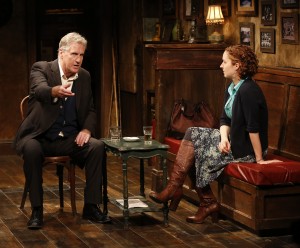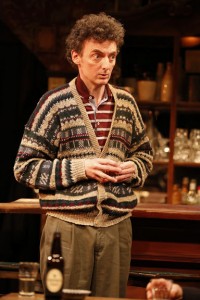The Birds, Conor McPherson’s creepy new play, is derived neither from Aristophanes nor Alfred Hitchcock. It does, however, share DNA with the 1963 film because both draw from a short story by Daphne du Maurier. (Hitchcock also used du Maurier novels as source material for Jamaica Inn and his Oscar-winning Rebecca.) Don’t expect to find real birds or even simulated ones in the pocket drama at 59E59 Theaters. Fans of the movie won’t find a pompous female ornithologist with environmental concerns or a schoolteacher with her eyes pecked out either.
Paranormal Problems
For the first production by Irish Repertory Theatre on its return to its 22nd Street location after a year’s renovation and exile, artistic director Charlotte Moore has chosen (or perhaps approved) Conor McPherson’s Shining City, a 2004 play about a psychiatrist and his patient who wrestle with secrets and regrets that is directed by longtime associate Ciarán O’Reilly. (Shining City was eventually seen on Broadway in 2006.) In some ways the play is a mixed bag: McPherson’s early works, such as The Weir (1997) and Port Authority (2003), rely on interrelated monologues to tell a story. In The Weir, for instance, a group of people gather in a bar and tell ghost stories, one by one. In later works, such as The Seafarer and The Night Alive, McPherson becomes less reliant on speeches than on give-and-take that resembles real conversation.
Shining City concerns a Dublin psychiatrist, Ian (Billy Carter), who has taken on a patient, John, a man who cannot sleep in his home since he saw the ghost of his dead wife, Maury, killed in a violent traffic accident. Played by Matthew Broderick with a deft Irish brogue, John is worried about his sanity. The memory of the apparition haunts him, and he cannot stay overnight in his home. John seeks Ian’s help in restoring him to sleep at night. In a series of near-monologues with the psychiatrist, John reviews his life and marriage.
Ian, meanwhile, has troubles of his own. He wants out of his marriage to Lisa Dwan’s Neasa, and when Neasa arrives and listens to him explain, she seems rather a dunce, cottoning to the fact that he’s leaving her long after the audience knows it. The couple have a row in his home office, and he assures her he’ll take care of her but that he won’t return to the marriage. There’s less give-and-take than there is of Ian’s staking out his position fully, and then Neasa delivering her side of the story. O’Reilly’s direction can’t disguise that the playwright is still adapting to conversational back-and-forth.
Anyone familiar with McPherson’s work knows that something eerie is going to happen, but when it does, unfortunately, the effect is much less chilling than it was in the Broadway production. Whether it’s due to Broderick’s laid-back delivery, which, although an appropriate choice for the character, somehow makes the proceedings too cozy, and the audience too comfortable, or whether O’Reilly’s staging simply fails to do the moment justice, is unclear.
But Broderick is doing better work than he has in a long time. He’s taken on a gigantic role and he’s never less than enjoyable in it. Billy Carter as the psychiatrist is also exemplary. His Ian is energetic, sympathetic, emotionally torn and yet willing to face hard truths. A late entrance by James Russell’s Laurence, a pickup for sex, reveals much about Ian, who abandoned the priesthood in order to marry Neasa. Yet a final scene further complicates the nature of Ian’s character, and one senses that perceptions are not to be relied upon. It calls to mind Hamlet’s observation, “There is more in heaven and earth, Horatio, than is dreamt of in your philosophy.” It's a good epigraph for the play’s finale as well.
That Ian’s name is the Gaelic version of “John” is a subtle hint at the haunting climax. The Irish Rep’s Shining City is a satisfying, if not ideal, rendering of what feels like a transitional play by an important modern playwright.
The Irish Rep’s Shining City plays through July 3 at the company’s refurbished home at 132 W. 22 St. in Manhattan. Evening performances are at 7 p.m. Tuesday and Thursday and at 8 p.m. Wednesday, Friday and Saturday. Matinees are at 3 p.m. Wednesday, Saturday and Sunday. For tickets, call Ovationtix at (212) 727-2737 or visit irishrep.org.
Chilled Irish Tales
The very first staging of The Weir at The Royal Court Theatre Upstairs in London shot to almost immediate acclaim, with nascent visionary playwright Conor McPherson winning a Laurence Olivier Award for Best New Play in 1997. Following incarnations of The Weir have starred current TV mainstays Brendan Coyle (of Downton Abbey fame) and Michelle Fairley (as a particularly aggrieved member of the Stark family in Game of Thrones). And The Weir does seem to require the same expressive vocal drama and expository storytelling that television shows afford us. With its extraordinary character appeal and its fascinating series of spine-chilling Irish folktales, the Irish Repertory Theatre's production of The Weir is a darkly bloodcurdling, utterly captivating take on McPherson’s well-crafted play.
Set in a rural Irish pub, bar owner Brendan (a serenely gruff Tim Ruddy) and friendly barflies Jim (John Keating), Jack (Paul O’Brien) and Finbar (Sean Gormley) try to welcome a lovely, mysterious import from Dublin, Valerie (an aptly cast Amanda Quaid), as she acclimates herself to her windy surroundings. The men proceed to tell haunting tales of faeries, poltergeists and abandoned houses, all the while struggling to reconcile their forced bachelorhood with their sudden, protective interest in Valerie—who has an eerie story of her own to tell.
Director Ciaran O’Reilly carefully fleshes out each character through the exquisite exposition of each individual story, courtesy of McPherson’s chillingly arresting words. Somehow, distinctly Irish turns of phrase possess an earthy accessibility under his pen, as well as a surprising amount of humor. There is an understated, rugged comradeship that the men share in their familiar curses and ubiquitous swigs of Guinness. The Irish flavor of it all is surpassingly delightful, as are the fantastical folktales borne out of that stout-and-song tradition; McPherson deftly paints his characters as traumatic products of their stories, and it’s difficult to distract yourself from their beguiling eeriness.
Valerie’s tale holds a deep, desperately weary grief. Jack’s dual yarns of a coldly enchanting faerie adventure and a haunting lost love both possess an expertly gleeful, then progressively sorrowful mannerism. Perhaps most harrowing are Jim and Finbar’s stories, for different reasons; an endearingly odd Keating imbues Jim with a trembling, wide-eyed respect for the supernatural, while Gormley’s Finbar is an uneasy skeptic, begrudgingly honest in his retelling of an eerie encounter, but steadfastly refusing to believe in anything out of the ordinary. But it is O’Brien’s gruff, garrulous take on Jack that gives the entire production that heady, hallucinatory magic. He keenly modulates the volume of his voice—whispering at climaxes and chuckling in practice disbelief—until it becomes an actor all its own. The back-from-hiatus (and excellent) Tim Ruddy makes us wonder why Brendan is still a bachelor.
Ciaran O’Reilly has woven each of these character’s stories with some unknowable alchemy. Even as a single actor seems to commandeer the stage with his or her tale, a magnificent change comes over their compatriots on stage: they become the audience. We are mirrored in their slack faces and uneasy composures; just as the seated audience writhes inwardly against our collective imaginations when Valerie narrates her ghostly tale, Jack, Jim, Brendan and Finbar cannot move. A magnificent design and sound/light team induce much of the trance-like state the audience enjoys.
Courtesy of scenic designer Charlie Corcoran, the bar room is a study in light and dark browns, cleverly synthesizing the homey, fire-crackling hearth ambiance perfect for storytelling. The lighting by Michael Gottlieb is an understated marvel dimming almost indiscernibly during the narrative sequences. During these instances, the audience hears a hollow, equally imperceptible whistling of wind, perhaps the most effective minimalist contribution to the play, overseen by Drew Levy. But the actors’ voices are so spellbinding that the whistling seems an organic soundtrack to their story.
The Weir ends much too quickly and the actors’ final exit leaves us with an irrational hope that they might come back on stage and tell us their hauntingly beautiful tales in their seductive Irish slang once more. Instead, we hear the familiar refrain of good luck, as Jack was accustomed to say before downing a pint, and the companionable reminder of the power of storytelling. In the end, when McPherson’s words have run out, we are left with a sweet, silent ache for some similar kind of chilling magic.
The Weir ran until Sept. 3 at The Irish Repertory Theatre at the DR2 Theatre (103 East 15th St. between Union Square East and Irving Pl.) in Manhattan. For more information, visit www.irishrep.org.










